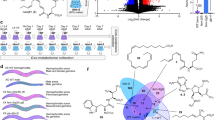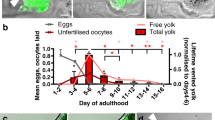Abstract
Excreted small-molecule signals can bias developmental trajectories and physiology in diverse animal species. However, the chemical identity of these signals remains largely obscure. Here we report identification of an unusual N-acylated glutamine derivative, nacq#1, that accelerates reproductive development and shortens lifespan in Caenorhabditis elegans. Produced predominantly by C. elegans males, nacq#1 hastens onset of sexual maturity in hermaphrodites by promoting exit from the larval dauer diapause and by accelerating late larval development. Even at picomolar concentrations, nacq#1 shortens hermaphrodite lifespan, suggesting a trade-off between reproductive investment and longevity. Acceleration of development by nacq#1 requires chemosensation and is dependent on three homologs of vertebrate steroid hormone receptors. Unlike ascaroside pheromones, which are restricted to nematodes, fatty acylated amino acid derivatives similar to nacq#1 have been reported from humans and invertebrates, suggesting that related compounds may serve signaling functions throughout metazoa.
This is a preview of subscription content, access via your institution
Access options
Access Nature and 54 other Nature Portfolio journals
Get Nature+, our best-value online-access subscription
$29.99 / 30 days
cancel any time
Subscribe to this journal
Receive 12 print issues and online access
$259.00 per year
only $21.58 per issue
Buy this article
- Purchase on Springer Link
- Instant access to full article PDF
Prices may be subject to local taxes which are calculated during checkout





Similar content being viewed by others
Data availability
The authors declare that the data supporting the findings of this study are available within the article and its supplementary information files.
References
von Reuss, S. H. & Schroeder, F. C. Combinatorial chemistry in nematodes: modular assembly of primary metabolism-derived building blocks. Nat. Prod. Rep. 32, 994–1006 (2015).
Gendron, C. M. et al. Drosophila life span and physiology are modulated by sexual perception and reward. Science 343, 544–548 (2014).
Vandenbergh, J. G. Male odor accelerates female sexual maturation in mice. Endocrinology 84, 658–660 (1969).
Ludewig, A. H. et al. Larval crowding accelerates C. elegans development and reduces lifespan. PLoS Genet. 13, e1006717 (2017).
Aprison, E. Z. & Ruvinsky, I. Sexually antagonistic male signals manipulate germline and soma of C. elegans hermaphrodites. Curr. Biol. 26, 2827–2833 (2016).
Ludewig, A. H. & Schroeder, F. C. in WormBook (ed. The C. elegans Research Community) https://doi.org/10.1895/wormbook.1.155.1 (2013).
Schroeder, F. C. Modular assembly of primary metabolic building blocks: a chemical language in C. elegans. Chem. Biol. 22, 7–16 (2015).
Butcher, R. A. Small-molecule pheromones and hormones controlling nematode development. Nat. Chem. Biol. 13, 577–586 (2017).
Frezal, L. & Felix, M. A. C. elegans outside the Petri dish. eLife 4, e05849 (2015).
Shi, C. & Murphy, C. T. Mating induces shrinking and death in Caenorhabditis mothers. Science 343, 536–540 (2014).
Maures, T. J. et al. Males shorten the life span of C. elegans hermaphrodites via secreted compounds. Science 343, 541–544 (2014).
Shi, C., Runnels, A. M. & Murphy, C. T. Mating and male pheromone kill Caenorhabditis males through distinct mechanisms. eLife 6, e23493 (2017).
Artyukhin, A. B. et al. Metabolomic “dark matter” dependent on peroxisomal β-oxidation in Caenorhabditis elegans. J. Am. Chem. Soc. 140, 2841–2852 (2018).
von Reuss, S. H. et al. Comparative metabolomics reveals biogenesis of ascarosides, a modular library of small molecule signals in C. elegans. J. Am. Chem. Soc. 134, 1817–1824 (2012).
Forsberg, E. M. et al. Data processing, multi-omic pathway mapping, and metabolite activity analysis using XCMS Online. Nat. Protoc. 13, 633–651 (2018).
Tautenhahn, R., Bottcher, C. & Neumann, S. Highly sensitive feature detection for high resolution LC/MS. BMC Bioinformatics 9, 504 (2008).
Pungaliya, C. et al. A shortcut to identifying small molecule signals that regulate behavior and development in Caenorhabditis elegans. Proc. Natl Acad. Sci. USA 106, 7708–7713 (2009).
Aprison, E. Z. & Ruvinsky, I. Counteracting ascarosides act through distinct neurons to determine the sexual identity of C. elegans pheromones. Curr. Biol. 27, 2589–2599 (2017).
He, J. et al. Distinct signals conveyed by pheromone concentrations to the mouse vomeronasal organ. J. Neurosci. 30, 7473–7483 (2010).
Izrayelit, Y. et al. Targeted metabolomics reveals a male pheromone and sex-specific ascaroside biosynthesis in Caenorhabditis elegans. ACS Chem. Biol. 7, 1321–1325 (2012).
Schulenburg, H. & Felix, M. A. The natural biotic environment of Caenorhabditis elegans. Genetics 206, 55–86 (2017).
Gems, D. & Riddle, D. L. Genetic, behavioral and environmental determinants of male longevity in Caenorhabditis elegans. Genetics 154, 1597–1610 (2000).
Srinivasan, J. et al. A blend of small molecules regulates both mating and development in Caenorhabditis elegans. Nature 454, 1115–1118 (2008).
Butcher, R. A., Fujita, M., Schroeder, F. C. & Clardy, J. Small-molecule pheromones that control dauer development in Caenorhabditis elegans. Nat. Chem. Biol. 3, 420–422 (2007).
Jeong, P. Y. et al. Chemical structure and biological activity of the Caenorhabditis elegans dauer-inducing pheromone. Nature 433, 541–545 (2005).
Ludewig, A. H. et al. Pheromone sensing regulates Caenorhabditis elegans lifespan and stress resistance via the deacetylase SIR-2.1. Proc. Natl Acad. Sci. USA 110, 5522–5527 (2013).
Golden, J. W. & Riddle, D. L. A pheromone influences larval development in the nematode Caenorhabditis elegans. Science 218, 578–580 (1982).
Hu, P. J. in WormBook (ed. The C. elegans Research Community) https://doi.org/10.1895/wormbook.1.144.1 (2007).
Kenyon, C. The plasticity of aging: insights from long-lived mutants. Cell 120, 449–460 (2005).
Kaplan, F. et al. Ascaroside expression in Caenorhabditis elegans is strongly dependent on diet and developmental stage. PLoS ONE 6, e17804 (2011).
Fielenbach, N. & Antebi, A. C. elegans dauer formation and the molecular basis of plasticity. Genes Dev. 22, 2149–2165 (2008).
Mangelsdorf, D. J. et al. The nuclear receptor superfamily: the second decade. Cell 83, 835–839 (1995).
Antebi, A., Yeh, W. H., Tait, D., Hedgecock, E. M. & Riddle, D. L. daf-12 encodes a nuclear receptor that regulates the dauer diapause and developmental age in C. elegans. Genes Dev. 14, 1512–1527 (2000).
Ludewig, A. H. et al. A novel nuclear receptor/coregulator complex controls C. elegans lipid metabolism, larval development, and aging. Genes Dev. 18, 2120–2133 (2004).
Magner, D. B. et al. The NHR-8 nuclear receptor regulates cholesterol and bile acid homeostasis in C. elegans. Cell Metab. 18, 212–224 (2013).
Thondamal, M., Witting, M., Schmitt-Kopplin, P. & Aguilaniu, H. Steroid hormone signalling links reproduction to lifespan in dietary-restricted Caenorhabditis elegans. Nat. Commun. 5, 4879 (2014).
Bargmann, C. I. & Horvitz, H. R. Control of larval development by chemosensory neurons in Caenorhabditis elegans. Science 251, 1243–1246 (1991).
Schackwitz, W. S., Inoue, T. & Thomas, J. H. Chemosensory neurons function in parallel to mediate a pheromone response in C. elegans. Neuron 17, 719–728 (1996).
Alcedo, J. & Kenyon, C. Regulation of C. elegans longevity by specific gustatory and olfactory neurons. Neuron 41, 45–55 (2004).
Apfeld, J. & Kenyon, C. Regulation of lifespan by sensory perception in Caenorhabditis elegans. Nature 402, 804–809 (1999).
Park, D. et al. Interaction of structure-specific and promiscuous G-protein-coupled receptors mediates small-molecule signaling in Caenorhabditis elegans. Proc. Natl Acad. Sci. USA 109, 9917–9922 (2012).
Maglich, J. M. et al. Comparison of complete nuclear receptor sets from the human, Caenorhabditis elegans and Drosophila genomes. Genome Biol. 2, research0029.1–research0029.7 (2001).
Wollam, J. & Antebi, A. Sterol regulation of metabolism, homeostasis, and development. Annu. Rev. Biochem. 80, 885–916 (2011).
Gems, D. & Partridge, L. Genetics of longevity in model organisms: debates and paradigm shifts. Annu. Rev. Physiol. 75, 621–644 (2013).
Maklakov, A. A. & Immler, S. The expensive germline and the evolution of ageing. Curr. Biol. 26, R577–R586 (2016).
Kuhn, F. & Natsch, A. Body odour of monozygotic human twins: a common pattern of odorant carboxylic acids released by a bacterial aminoacylase from axilla secretions contributing to an inherited body odour type. J. R. Soc. Interface 6, 377–392 (2009).
Long, J. Z. et al. The secreted enzyme PM20D1 regulates lipidated amino acid uncouplers of mitochondria. Cell 166, 424–435 (2016).
Long, J. Z. et al. Ablation of PM20D1 reveals N-acyl amino acid control of metabolism and nociception. Proc. Natl Acad. Sci. USA 115, E6937–E6945 (2018).
Schmelz, E. A., Engelberth, J., Alborn, H. T., Tumlinson, J. H. & Teal, P. E. A. Phytohormone-based activity mapping of insect herbivore-produced elicitors. Proc. Natl Acad. Sci. USA 106, 653–657 (2009).
Weiss, L. C. et al. Identification of Chaoborus kairomone chemicals that induce defences in Daphnia. Nat. Chem. Biol. 14, 1133–1139 (2018).
Brenner, S. The genetics of Caenorhabditis elegans. Genetics 77, 71–94 (1974).
Sulston, J. & Hodgkin, J. in The Nematode Caenorhabditis elegans (ed. Wood, W. B.) 587–606 (Cold Spring Harbor Laboratory Press, 1988).
Seydoux, G., Savage, C. & Greenwald, I. Isolation and characterization of mutations causing abnormal eversion of the vulva in Caenorhabditis elegans. Dev. Biol. 157, 423–436 (1993).
MacNeil, L., Watson, E., Arda, H. E., Zhu, L. J. & Walhout, A. J. M. Diet-induced developmental acceleration independent of TOR and insulin in C. elegans. Cell 153, 240–252 (2013).
Frand, A. R., Russel, S. & Ruvkun, G. Functional genomic analysis of C. elegans molting. PLoS Biol. 3, e312 (2005).
Acknowledgements
This work was supported in part by National Institutes of Health grants R01GM113692 (to F.C.S.), R01GM088290 (to F.C.S.) and T32GM008500 (to R.N.B.), R01GM126125 (to I.R.), and by National Science Foundation (NSF) grants IOS-1708518 and IOS-1755244 (to I.R.). F.C.S. is a faculty scholar of the Howard Hughes Medical Institute. This work made use of the Cornell University NMR Facility, which is supported, in part, by the NSF through MRI award CHE-1531632. We thank N. Movahed and D. Kiemle for assistance with MS and NMR spectroscopy and R. Smith and G. Horvath for technical support.
Author information
Authors and Affiliations
Contributions
I.R. and F.C.S. supervised the study. A.H.L., A.B.A., I.R. and F.C.S. designed experiments. A.H.L., A.B.A., E.Z.A., P.R.R., D.C.P., R.N.B., P.G. and O.P. performed chemical and biological experiments. R.N.B. and Y.K.Z. performed syntheses. I.R. and F.C.S. wrote the paper with input from the other authors.
Corresponding authors
Ethics declarations
Competing interests
The authors declare no competing interests.
Additional information
Publisher’s note: Springer Nature remains neutral with regard to jurisdictional claims in published maps and institutional affiliations.
Supplementary information
Supplementary Information
Supplementary Tables 1–15 and Supplementary Figures 1–14
Supplementary Note
Synthetic procedures
Supplementary Data Set
Data for time-of-development assays based on morphological criteria. Includes data for time-of-development assays and molting curves shown in Figs. 1b and 3b,d, and Supplementary Figs. 5b, 7b,c, 9 and 12b,c.
Rights and permissions
About this article
Cite this article
Ludewig, A.H., Artyukhin, A.B., Aprison, E.Z. et al. An excreted small molecule promotes C. elegans reproductive development and aging. Nat Chem Biol 15, 838–845 (2019). https://doi.org/10.1038/s41589-019-0321-7
Received:
Accepted:
Published:
Issue Date:
DOI: https://doi.org/10.1038/s41589-019-0321-7
This article is cited by
-
Pheromone-based communication influences the production of somatic extracellular vesicles in C. elegans
Nature Communications (2024)
-
Acylspermidines are conserved mitochondrial sirtuin-dependent metabolites
Nature Chemical Biology (2024)
-
Sex-specificity of the C. elegans metabolome
Nature Communications (2023)
-
C. elegans ageing is accelerated by a self-destructive reproductive programme
Nature Communications (2023)
-
Males induce premature demise of the opposite sex by multifaceted strategies
Nature Aging (2022)



